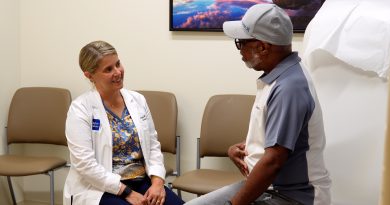Breathing Hope: unveiling the reality of pulmonary fibrosis and the journey to a new breath
Pulmonary fibrosis is considered a rare lung disease but still affects 207,000 people in the United States, with 58,000 new cases diagnosed each year. It is more common in men than women and typically affects people over the age of 50.
This condition happens when the normally thin walls of the air sacs of the lung get thick and scarred. This scarring makes the lungs less efficient at delivering oxygen to the bloodstream and more difficult to expand the lungs—which make it harder to breathe and can cause shortness of breath.
“Pulmonary fibrosis is a life-threatening illness,” says Dr. Ivan Rosas, professor of medicine and section chief of pulmonary, critical care and sleep medicine at Baylor College of Medicine and pulmonologist at the Lung Institute. “It is a progressive disease, and there is no cure. Newer medications may help slow the disease progression, and we are doing research on improving these therapies, but it is a serious disease that sometimes leads to a need for transplant.”
The symptoms of pulmonary fibrosis can vary from person to person, but they generally include:
- Shortness of breath: One of the hallmark symptoms of pulmonary fibrosis is difficulty in breathing, especially during physical activity. As the disease progresses, even simple tasks like climbing stairs can become exhausting.
- Dry cough: A persistent and dry cough is another common symptom. This cough can be quite bothersome and often worsens over time.
- Fatigue: Reduced lung function can lead to inadequate oxygen exchange, resulting in fatigue and a lack of energy.
- Chest discomfort: Some individuals might experience chest discomfort or pain due to the restricted lung capacity and the strain on the respiratory system.
- Unintended weight loss: As the body works harder to breathe and oxygenate tissues, it may lead to unintentional weight loss.
Patients who have pulmonary fibrosis may be prone to a more sedentary lifestyle because exercising is difficult. Each person diagnosed with pulmonary fibrosis reacts differently: some people stay in a stable condition for years while others experience rapidly increasing symptoms and worsening health. Many things like smoking can lead to pulmonary fibrosis, but often the cause is unknown. Some types of the disease are genetic and run in families.
 Lolita Slagle, a patient at the Lung Institute, has pulmonary fibrosis, and later found out she is not the only one in her family with it. But her symptoms came on gradually, so she did not know anything was wrong.
Lolita Slagle, a patient at the Lung Institute, has pulmonary fibrosis, and later found out she is not the only one in her family with it. But her symptoms came on gradually, so she did not know anything was wrong.
“I went into the doctor for an annual physical and they found my oxygen level was very low,” remembers Slagle. “I had felt fine and had no symptoms but was sent to the ER.”
Unfortunately, the disease progressed to the point where Slagle needed a lung transplant. In December 2021, she underwent a single-lung transplant performed by Dr. Gabriel Loor, associate professor in the Michael E. DeBakey Department of Surgery at Baylor.
“In cases of advanced pulmonary fibrosis, where the disease has progressed beyond the point of effective medical intervention, a lung transplant can often be the only lifeline left,” says Loor. “The transplant not only offers the patient a chance at extended life but also a renewed quality of life, allowing them to regain their independence and vitality.”
Slagle is grateful for her new breath and the care she received during her surgery and aftercare.
“Dr. Rosas, Dr. Loor and that whole transplant team were just wonderful,” Slagle says. “I really feel well cared for by that group.”
By Tiffany Harston, communications associate with the Michael E. DeBakey Department of Surgery



